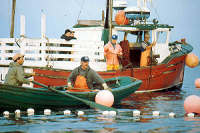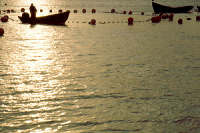|
As the president of the St Margaret's Bay Tuna Fishermen's Association, Conrad hopes the prestige of the summit will lead the federal department of fisheries and oceans (DFO) to place more priority on this environmentally friendly, and community friendly, way of fishing. "The trapnet fishery is not a little thing that happens in St Margaret's Bay," said Conrad.
"It is a fishery that is held in high regard in other countries. What I'm really hoping for is that the DFO in Atlantic Canada would come to a greater recognition of the benefits of trapnet fishing and the need to preserve and develop and grow that.
"With trapnet fishing, only small portions of the fish stocks are captured, creating a healthy future for the fish and the fishermen. The trapnet fishery does not impact the environment," said Conrad.
"The only contact with the sea floor would be the anchor system. There is no disruption of the ocean environment. You wait and capture what comes to you rather than be a hunter. It serves as a braking effect on the other fisheries that are more destructive."
In the long term, Conrad would like to see DFO invest more money into researching the patterns and populations of the migratory stocks. "We know far more about the surface of the moon than we do about our own oceans."
In the short term, his organization is trying to fix another problem: the fishery tends to close before the tuna leave the bay. Last autumn, 15 tuna swam into one trap and were released after the quota had been reached on September 30. Fishery nets $15 million
Apart from St Margaret's Bay, there are six other tuna fleets in Atlantic Canada, employing harpoon, tended line, and rod and reel. The fishery, worth about $15 million a year, closes when the quota across the seven tuna fleets is met, usually before peak prices are reached in late autumn. Under the present system, each fleet is allocated a cap, but the combined cap exceeds the regional quota of 595 MT (metric tonnes) by a considerable margin. All tuna are tagged at capture and monitored at landing.
But the quota will have been met before some fleets have reached their cap. "It promotes a totally competitive race for fish", said Conrad.
As an alternative, the local tuna association wants fleet quotas that would be managed by the fishermen.
"This would help stabilize the communities who depend on tuna," said Conrad. Each fleet would fish until their quota was met, unaffected by another fleet's superior catch that might otherwise bring the season to an early end.
The catch in St Margaret's Bay has been falling below its fleet cap. Last year it was set at 105 MT, roughly 18 per cent of the regional quota, but the fleet landed only 100 tuna, just five per cent of the regional catch.
If the rules are changed, the local tuna association will have to accept a quota well below the current cap, as will some other fleets. The payoff will be in letting each fleet pace the catch so they can fish later into the year, harvesting larger and better quality fish for higher prices.
Conrad thinks this co-operative approach, to be debated by industry and government in late February, may encourage fishermen to work together in other areas, including marketing. "Give us fleet quotas and we can do some wonderful things."
Catches up and down
The tuna catch in St Margaret's Bay has been up and down for decades. Up until the 1940s, about 50 families lived off the tuna fishery, which began its decline as the groundfish fishery improved. The tuna returned in great numbers in the 60s and 70s. Then in the 80s and early 90s, very little tuna was caught, and in some years, none at all. But the tuna have been coming back since the mid-90s. In 1994, the St Margaret's Bay fleet landed more bluefin tuna than in all the previous decade. In that year the combined value of the tuna and mackerel trapnet fishery in the bay reached $4 million.
The catch was steady for a while after that, and then dropped. At the same time prices fell from an average $20 a pound to about $10, although the odd fish will still get $40 a pound. The tuna are smaller, too.
Whereas the odd farmed tuna would go dressed for 800 or 900 pounds, the average tuna last season weighed 616 pounds, "making it a challenge for our fleet to survive," said Robert Conrad. But in the big picture, the outlook is still better than it was and Conrad is upbeat. "The better days may yet be ahead of us."
Click here for further information about trapnets
Top
|

